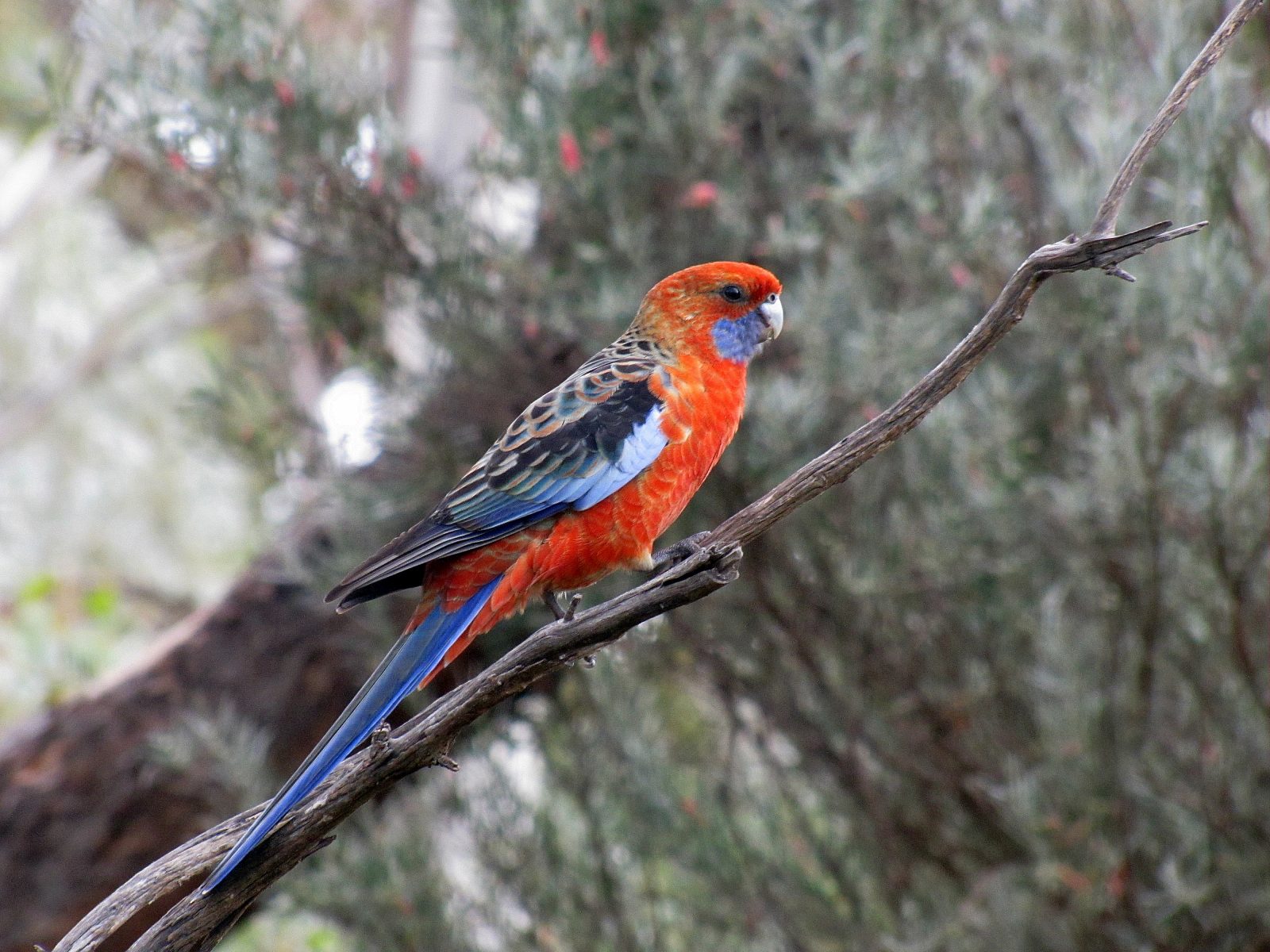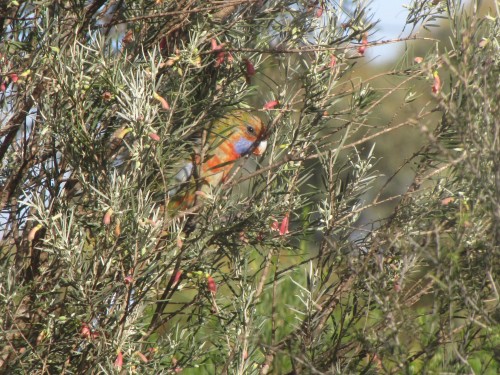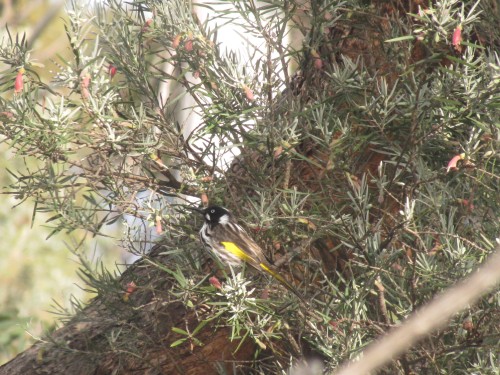Eastern Rosella still present
Over the last few months we have had a single Eastern Rosella frequently visiting our garden. This beautiful bird recently came to visit our bird bath just outside our sun room. I was able to get several good photos before it flew off again.
This individual has been hanging around now for several months. This species does not naturally occur around here, so I assume it is an aviary escapee. I have previously seen one a few kilometres from our home.
The Eastern Rosella is relatively common in the Adelaide region where it was introduced some years ago. Its normal range is south eastern Australia.
This particular individual must be feeling lonely. It keeps on following our resident family of Mallee Ringneck parrots. In return, they show quite a deal of antagonism towards it, chasing it and generally harassing it. They were at it again this evening, causing quite a stir in the garden.
Related Articles:
- Eastern Rosella – a new species for our garden list
- Eastern Rosella
- Yellow Rosella
- Adelaide Rosella
- Australian Ringneck (Mallee Ringneck)
Eastern Rosella – a new species for our garden list
Eastern Rosellas are one of the colourful parrot species to be found here in Australia. It is a relatively common parrot found in south eastern Australia and Tasmania. It has been introduced into the Mt Lofty Ranges and Adelaide region of south Australia as well as New Zealand.
Here in Murray Bridge I’ve only recorded it once several years ago. On that occasion it appeared to be an aviary escape. The nearest naturally occurring birds are some 60 kilometres to the west.
Over recent days we have had a single Eastern Rosella flying around our garden. This is a new species for my garden list. It does not appear to be a cage bird as it is very flighty. I struggled to get close enough for a reasonable photo. The photos on this post have been enhanced – zoomed in and brightened to show the beautiful colours. Consequently they are not top quality shots.
The behaviour of this individual was interesting. We have several Mallee Ringnecks resident on our property. Recently they produced two young ones that follow them everywhere and beg to be fed. The Eastern Rosella tried to adopt this family who were having none of it. They tried to chase it away but it was most insistent and would fly up and sit close to one of the ringnecks. The ringnecks would then attempt to chase it away again. This continued for about twenty minutes before the rosella gave and flew away. It has been back several times so I don’t know whether it intends taking up residence or not.
It would be a very colourful addition to our garden birds.
Related articles:
Eastern Rosella
On our visit last week to the Wittunga Botanic Gardens in the Adelaide Hills, I observed quite an interesting range of birds in the gardens and near the lake. There were plenty of Pacific Black Ducks and Wood Ducks, all clamoring for a piece of the action if any people came along – whether or not they looked like have a picnic. Ducks are ever hopeful of some food handouts.
I saw Eurasian Coots and Dusky Moorhens on the water and two Little Pied Cormorants perching on dead branches sticking out over the water of the lake. Two – perhaps a pair – of Masked Lapwings patrolled sections of the lawned areas used by picnickers. Welcome Swallows swooped low over the water and nearby bushy area. The trees were abuzz with Rainbow Lorikeets in a feeding frenzy. I also saw several Musk Lorikeets, a smaller parrot than the Rainbows but just as noisy. As for the larger parrot species I noticed several Galahs feeding on the lawns while a single Corella, I presume it was a Little Corella, flew overhead at one stage. I didn’t get a close enough look to be certain.
One species I was delighted to be able to see and photograph was the Eastern Rosella. In South Australia this species is mainly confined to the South East region of the state and to parts of the suburbs of Adelaide and the Adelaide Hills. The above photo shows up its brilliant colours. This is one occasion when I didn’t have to chase the bird in question, as it seemed happy to pose for me on the edge of the path.
Two days after taking the above photo, I was surprised to see a single Eastern Rosella at the Murraylands Homes for the Aged in Murray Bridge. I was there visiting my mother-in-law. This is the first time I have recorded this species anywhere near here. My closest other sightings are at least 60km to the west. By its behaviour it could well have been an escapee from someone’s aviary.
Related articles:
A raft of rosellas

Earlier this week I spotted several birds coming in to land on the swimming pool cover in my garden. I keep the cover on the pool during the winter months to stop twigs from nearby trees falling into the water. The cover also stops excessive evaporation of the water.
During recent months, however, the winter rains have been quite good here where I live in Murray Bridge, South Australia. Other regions have been in serious drought conditions. Whenever it rains, small, shallow puddles of water gather on top of the pool cover. These pools are very inviting to the local birds and any others passing by.
When I stealthily crept closer to the pool I discovered three Adelaide Rosellas had landed on the pool cover and they were having a lovely time splashing around in the shallow pools of water. I crept quietly back into the house to get my camera, but by the time I came out again they were ready to leave. I didn’t get a chance to take some photos.
When I first moved to my home on the western edge of town over 30 years ago, I never recorded Adelaide Rosellas in my garden. Over the last ten to 15 years, their visits have become more and more frequent. Sometimes several months go by without sighting them, and then I will see some several months in a row. I guess you could say that their visits are somewhat sporadic. I certainly cannot call them a resident species like the Mallee Ringnecks which are always around somewhere on my five-acre block.
The Adelaide Rosella is a sub-species of the Crimson Rosella, common here in the southern parts of South Australia, as well as throughout the eastern states. I have also seen the Yellow Rosella nearby, another sub-species.
Because I didn’t get a chance to get a photo of the three visitors this week, I have used a photo of one taken some years ago (see above).
Feeding Adelaide Rosellas
Last weekend we were having breakfast in our sun-room when four Adelaide Rosellas flew into one of the bushes in our garden, an Eremophila youngii (see photo above). I had the camera ready for many minutes but they would not come out into full sunlight and the above photo is the best I captured on this occasion. Just one bird is seen peeking out to see what was happening around it. The others were hidden in the foliage, busy feeding on the nectar in the flowers.
The Adelaide Rosella is now a frequent visitor to our garden. It is a race of the widespread Crimson Rosella and confined to the Adelaide region, Mt Lofty Ranges and mid-north of South Australia. Its occurrence here in Murray Bridge is a relatively recent extension of that range.
Parrots occurring in our garden in Murray Bridge include:
- Adelaide Rosella (regular visitor, possibly breeding)
- Crimson Rosella (occasional)
- Eastern Rosella (regular)
- Mallee Ringneck (resident breeding)
- Galah (resident breeding)
- Rainbow Lorikeet (regular)
- Purple-crowned Lorikeet (regular)
- Musk Lorikeet (occasional)
- Budgerigar (rare)
- Sulphur-crested Cockatoo (rare)
- Little Corella (occasional)
- Yellow-tailed Black-cockatoo (once only)
- Cockatiel (occasional)
- Red-rumped Parrot (occasional)
Over the years we have lived here we have planted many native Australian plants, not only for their attractiveness when they flower, but also to attract our native wildlife, especially the birds. We have quite a few eremophilas, grevilleas and correas as well as many others. The particular bush shown in the photo has flowers on it for much of the year so the rosellas and honeyeaters head for it on a daily basis. Below is another photo of the same bush, this time with a New Holland Honeyeater having a feed.
Further reading:
- Get out of my patch
- Red wattlebird in Eremophila bush
- Mallee Native Plants Nursery – my wife’s site about Australian plants







